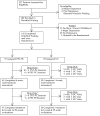Problem-solving treatment and coping styles in primary care for minor depression
- PMID: 19045962
- PMCID: PMC2593861
- DOI: 10.1037/a0012617
Problem-solving treatment and coping styles in primary care for minor depression
Abstract
Research was undertaken to compare problem-solving treatment for primary care (PST-PC) with usual care for minor depression and to examine whether treatment effectiveness was moderated by coping style. PST-PC is a 6-session, manual-based, psychosocial skills intervention. A randomized controlled trial was conducted in 2 academic, primary care clinics. Those subjects who were eligible were randomized (N = 151), and 107 subjects completed treatment (57 PST-PC, 50 usual care) and a 35-week follow-up. Analysis with linear mixed modeling revealed significant effects of treatment and coping, such that those in PST-PC improved at a faster rate and those initially high in avoidant coping were significantly more likely to have sustained benefit from PST-PC.
Figures



References
-
- Aiken L, West S. Multiple Regression: Testing and Interpreting Interactions. Thousand Oaks, CA: Sage; 1991.
-
- Barrett J, Barrett J, Oxman T, Gerber P. The prevalence of psychiatric disorders in a primary care practice. Arch Gen Psychiatry. 1988;45:1100–1106. - PubMed
-
- Barrett J, Williams J, Oxman T, Frank E, Katon W, Sullivan M, et al. Treatment of dysthymia and minor depression in primary care: A randomized trial in patients age 18-59 years. Journal of Family Practice. 2001;50:405–412. - PubMed
-
- Beekman A, Deeg D, vanTilburg T, Smit J, Hooijer C, vanTilburg W. Major and minor depression in later life: a study of prevalence and risk factors. Journal of Affective Disorders. 1995;36:65–75. - PubMed
-
- Billings A, Moos R. Coping, stress, and social resources among adults with unipolar depression. J Personality & Social Psychology. 1984;46:877–891. - PubMed

